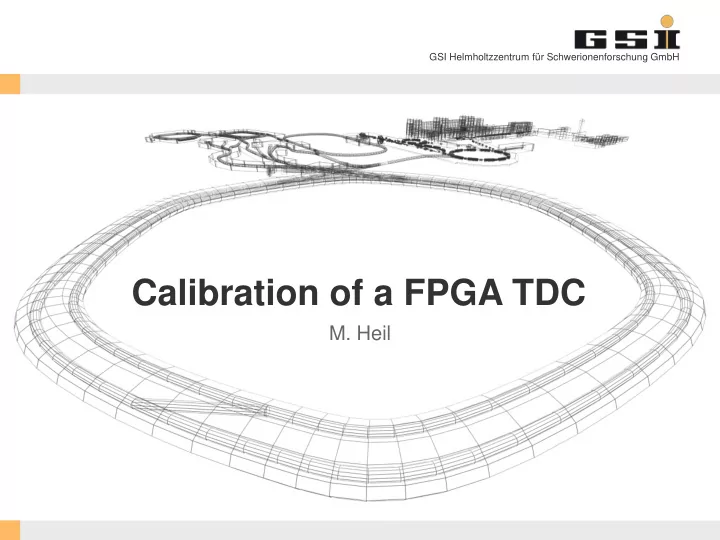

GSI Helmholtzzentrum für Schwerionenforschung GmbH Calibration of a FPGA TDC M. Heil GSI Helmholtzzentrum für Schwerionenforschung GmbH
Time-over-Threshold measurements signal signal threshold integrated signal threshold ToT leading edge trailing edge ToT leading edge trailing edge Conversion from an amplitude or charge measurement to a ToT=t le -t te time measurement. GSI Helmholtzzentrum für Schwerionenforschung GmbH
W orking principle of a “normal” TDC Time is measured between start and stop signal. Each bin has same time duration. Time measurement is limited to a certain number of channels. Calibration with a time calibrator. Δ t 250 calibration with slope common start 200 Time in ns 150 100 individual stop 50 0 0 20 40 60 80 100 Channels GSI Helmholtzzentrum für Schwerionenforschung GmbH
Working principle of a FPGA TDC Time measurement split in coarse (clock cycle) and fine (channel) time. coarse time clock fine time signal GSI Helmholtzzentrum für Schwerionenforschung GmbH
Working principle of a FPGA TDC Time measurement split in coarse (clock cycle) and fine (channel) time. LVDS Signal is sampled via delays of carry chain of FPGA. Signal level is recorded in logic modules (flip flops) coarse time clock fine time signal Results are stored in a buffer and can be read out later by a read-out trigger. Delays are not constant !!! Every channel has a different bin size. GSI Helmholtzzentrum für Schwerionenforschung GmbH
Calibration of times GSI Helmholtzzentrum für Schwerionenforschung GmbH
Calibration of times time in ns running sum of bins 𝑗=𝑐𝑗𝑜 𝑔𝑗𝑜𝑓𝑈𝑗𝑛𝑓 𝑐𝑗𝑜 = 𝑑𝑝𝑣𝑜𝑢𝑡(𝑗) 𝑗=0 clockTime 𝑗=𝑛𝑏𝑦 𝑑𝑝𝑣𝑜𝑢𝑡(𝑗) 𝑗=0 t_ns=clockCycle*clockTime - fineTime Calibration done channel by channel as look-up table channel GSI Helmholtzzentrum für Schwerionenforschung GmbH
Overflow of coarse counter The coarse counter of Tamex2 (Ptof) is reset at 8191. Time differences for which one coarse counter is reset have peculiar times. This has to be corrected. e.g.: while(tt-tl<0){ tt=tt+2048*clockTime; } The coarse counter of VFTX2 (LOS) is reset at 2047. Time differences between LOS and Ptof have to be corrected for this. GSI Helmholtzzentrum für Schwerionenforschung GmbH
Time-of-flight measurements in Cave C All times are measured relative to one common clock signal. PToF clock distribution GSI Helmholtzzentrum für Schwerionenforschung GmbH
Pictures of setup and FPGA TDCs ToF wall TAMEX3 TAMEX2 VFTX2 GSI Helmholtzzentrum für Schwerionenforschung GmbH
Advantages of FPGA TDC Long time differences can be measured accurately by dividing the time into a coarse and fine measurement. FPGA TDC measures time differences with a precision of up to σ t ~7 ps. It can be calibrated with physics data. No time calibrator necessary. All events within a large trigger window of ± 10 µs can be stored and read out later by a read-out trigger. It can handle multi-hits. All detectors measure relative to same clock signal. GSI Helmholtzzentrum für Schwerionenforschung GmbH
Recommend
More recommend